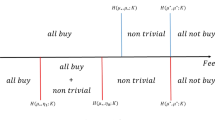Abstract
Production capacity decision under random demand is an important factor that significantly effects supply chain profits. It is realized in decentralized supply chains that the suppliers build capacity levels that are less than optimal for the total supply chain, since the supplier incurs all the cost and bears all the risk for the built capacity. To improve the supply chain performance, we analyze supply chain contracts considering capacity decisions in a two-party supply chain composed of a single manufacturer and a single supplier. We analyze and compare four well-known contracts, namely, simple wholesale price only contract, linear contract, cost sharing contract and revenue sharing contract under symmetric and asymmetric information about the supplier’s capacity building cost. The choice of the contract and determining the optimal contract parameters might be difficult for the manufacturer, especially if he has incomplete information about the supplier. In the asymmetric information models, we analyze the screening problem of the manufacturer when designing a menu of contracts without exact knowledge of the supplier’s capacity cost. We determine the optimal menu of contracts designed for both high and low cost suppliers and analyze their results through numerical experiments. Focusing on the capacity decisions under random demand, we aim to answer the three questions: (i) Which contracts coordinate the supply chain; (ii) Which contracts allow for any division of the supply chains profit among the firms; and (iii) Which contracts are worth adopting. We find the optimal contract parameters, determine the respective profits obtained by the supply chain members, and find which contracts would be better to use for the companies depending on the system parameters in different settings by analyzing and comparing the efficiencies of the contracts.
Similar content being viewed by others
References
Bolton P, Dewatripont M (2005) Contract theory. MIT Press, Cambridge and London
Bresnahan T, Reiss P (1985) Dealer and manufacturer margins. Rand J Econ 16(2):253–268
Cachon G (2003) Supply chain coordination with contracts. In: Graves S, de Kok T (eds) Handbooks in operations research and management science. Supply chain management. North-Holland
Cachon G, Lariviere M (1999) Capacity choice and allocation: strategic behaviour and supply chain performance. Manag Sci 45(8):1091–1108
Cachon G, Lariviere MA (2001) Contracting to assure supply: how to share demand forecasts in a supply chain. Manag Sci 47(5):629–646
Cachon G, Lariviere M (2005) Supply chain coordination with revenue-sharing contracts: strengths and limitations. Manag Sci 51(1):30–44
Chen F (2001) Information sharing and supply chain coordination. In: de Kok G, Graves SC (eds) Handbooks in operations research and management science: supply chain management, vol 7. North-Holland, Amsterdam
Chu W (1992) Demand signalling and screening in channels of distribution. Mark Sci 11(4):327–347
Corbett C, Groote X (2000) A supplier’s optimal quantity discount policy under asymmetric information. Manag Sci 46:444–450
Corbett C (2001) Stochastic inventory systems in a supply chain with asymmetric information: cycle stocks, safety stocks, and consignment stock. Oper Res 49(4):487–500
Corbett C, Zhou D, Tang C (2004) Designing supply contracts: contract type and information asymmetry. Manag Sci 50(4):550–559
Desai PS, Srinivasan K (1995) Demand signalling under unobservable effort in franchising: linear and nonlinear price contracts. Manag Sci 41(10):1
Erkoc M, Wu D (2005) Managing high-tech capacity expansion via reservation contracts. Prod Oper Manag 14(2):232–251
Ha A (2001) Supplier-buyer contracting: asymmetric cost information and cutoff level policy for buyer participation. Nav Res Logist 48:41–64
Jin M, Wu D (2007) Capacity reservation contracts for high-tech industry. Eur J Oper Res 176(3):1659–1677
Kaya M, Özer Ö (2009) Quality risk in outsourcing: non-contractible product quality and private quality cost information. Nav Res Logist 56:669–685
Lariviere M, Porteus E, (2001) Selling to the newsvendor: an analysis of price-only contracts. Manuf Serv Oper Manag 3(4):293–305
Lee HL, So KC, Tang CS (2000) The value of information sharing in a two-level supply chain. Manag Sci 46(5):626–643
Lv F, Ma S, Guan X (2015) The implication of capacity reservation contracts in assembly system with asymmetric demand information. Int J Prod Res 53(18):5564–5591
Mathur PP, Shah J (2008) Supply chain contracts with capacity investment decision: two-way penalties for coordination. Int J Prod Econ 114(1):56–70
Özer Ö, Wei W (2006) Strategic commitments for an optimal capacity decision under asymmetric forecast information. Manag Sci 52(8):1238–1257
Pasternack B (1985) Optimal pricing and return policies for perishable commodities. Mark Sci 4:133–140
Ren Z, Cohen M, Ho T, Terwiesch C (2010) Information sharing in a long-term supply chain relationship: the role of customer review strategy. Oper Res 58(1):81–93
Serel D, Dada M, Moskowitz H (2001) Sourcing decision with capacity reservation contracts. Eur J Oper Res 131(3):635–648
Taylor TA, Plambeck EL (2007) Simple relational contracts to motivate capacity investment: price only vs. price and quantity. Manuf Serv Oper Manag 9(1):94–113
Taylor TA, Plambeck EL (2007) Supply chain relationships and contracts: the impact of repeated interaction on capacity investment and procurement. Manag Sci 53(10):1577–1593
Tomlin B (2003) Capacity investments in supply chains: sharing the gain rather than sharing the pain. Manuf Serv Oper Manag 5(4):317–333
Tsay A (1999) The quantity flexibility contract and supply-customer incentive. Manag Sci 45(11):1339–1358
Tsay A, Nahmias S, Agrawal N (1999) Modeling supply chain contracts: a review. In: Tayur S, Ganeshan R, Magazine M (eds) Quantitative models for supply chain management. Kluwer, Boston
Van Mieghem JA, Dada M (1999) Price versus production postponement capacity and competition. Manag Sci 45(12):1639–1649
Whang S (1995) Coordination in operations: a taxonomy. J Oper Manag 12:413–422
Wu D, Erkoc M, Karabuk S (2005) Managing capacity in the high-tech industry: a review of literature. Eng Econ 50(2):125–158
Author information
Authors and Affiliations
Corresponding author
Rights and permissions
About this article
Cite this article
Kaya, O., Caner, S. Supply chain contracts for capacity decisions under symmetric and asymmetric information. Cent Eur J Oper Res 26, 67–92 (2018). https://doi.org/10.1007/s10100-017-0474-y
Published:
Issue Date:
DOI: https://doi.org/10.1007/s10100-017-0474-y




